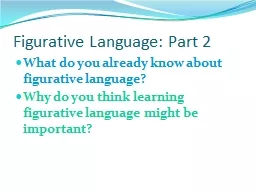

What do you already know about figurative language Why do you think learning figurative language might be important Terms You Know Simile Metaphor Personification Terms You Will Know Onomatopoeia ID: 576402
Download Presentation The PPT/PDF document "Figurative Language: Part 2" is the property of its rightful owner. Permission is granted to download and print the materials on this web site for personal, non-commercial use only, and to display it on your personal computer provided you do not modify the materials and that you retain all copyright notices contained in the materials. By downloading content from our website, you accept the terms of this agreement.
Slide1
Figurative Language: Part 2
What do you already know about figurative language?
Why do you think learning figurative language might be important?Slide2
Terms You Know:
Simile
Metaphor
PersonificationSlide3
Terms You Will Know:
Onomatopoeia
Alliteration
HyperboleSymbolism
Imagery Slide4
Onomatopoeia
An onomatopoeia is
a word that represents a sound
.
In other words, it’s a sound in word form. Slide5
Onomatopoeia Examples
Example #1:
The firecracker made a loud “ka-boom!”
Example #2:
I heard a “swoosh” at the basketball game.Slide6
moo
Onomatopoeia
ring
crunch
splatSlide7Slide8Slide9
Listen for the Onomatopoeia
Mrs.
Munger's
ClassSlide10
Activity 1: Brainstorm
With the person sitting next to you,
write a bunch of onomatopoeias
. You can use
nouns
and
verbs
—like “buzz” and “click” or “buzzed” and “clicked.”
This is a competition! When you get to
20 onomatopoeia
, raise your hands!Slide11
Activity 2: Descriptive Sentences
By yourself, write
3
descriptive sentences. Each one must use a
different
onomatopoeia.
Each person will get to share his/her best one!Slide12
Closing Onomatopoeia
What is an onomatopoeia?
Why might you use an onomatopoeia in your writing?Slide13
Alliteration
Alliteration is
the repeating of consonant sounds (not vowels) at the beginning of words.
What are consonants? Slide14
Alliteration Examples
Example #1:
Peter Piper picked a peck of pickled peppers.
Example #2: It was a slippery snake. Slide15
What about vowels?
“Alice ate an apple” is not alliteration.
It is called something else that we will learn during our poetry unit.
The term “alliteration” only works for words that start with consonants—not vowels.Slide16
What the purpose?
The purpose of alliteration is
to create a consistent
pattern
that catches the mind's eye and focuses attention.
The
w
ild
w
aves
w
ished for
w
inter.Slide17
In Stories and Poetry…
Fresh Fish
Do you like
f
resh
f
ish?
It's just
f
ine at
F
inney's Diner.
F
inney also has some
f
resher
f
ishthat's f
resher and much finer.But his best fish is his freshest fish
and Finney says with pride,"The f
inest fish at Finney's is
my freshest fish,
French-fried!""Oh say can you say" Dr. Seuss, 1979 Slide18
Sports Love AlliterationSlide19
Ads on the InternetSlide20
ProductsSlide21
Store NamesSlide22
Is it alliteration?
The cow counted sheep in order to fall asleep.Slide23
Is it alliteration?
I see the sun shine through my window.Slide24
Is it alliteration?
He quickly clicked the keyboard. Slide25
Is it alliteration?
Either elephant might eat eels. Slide26
Activity 1:
Read the letter and highlight examples of similes, metaphors, and alliteration. If you need to change the color key, do it!
23 Similes
7 Metaphors7+ AlliterationSlide27
Activity 2: Tongue Twisters
Make
5 twisters
of your own. Each one must be a complete sentence with at least 5 words. Slide28
Compare and Contrast
Alliteration RhymingSlide29
Closing Alliteration
What is alliteration?
How does it make reading more interesting?
Why might you want to use it in your writing?